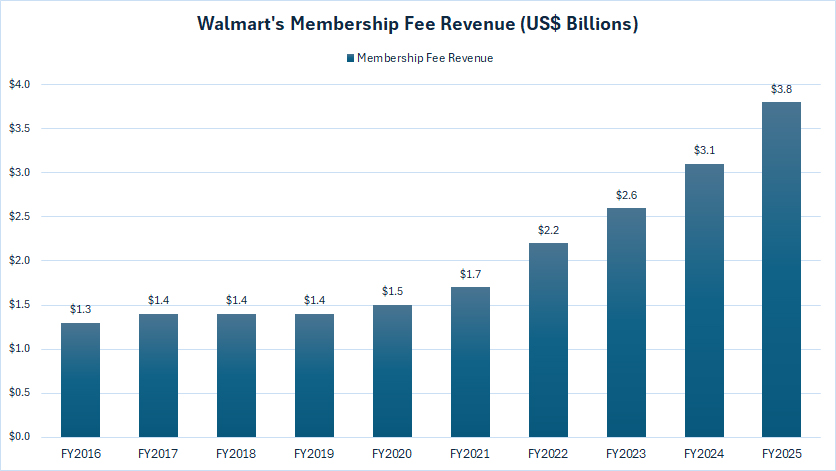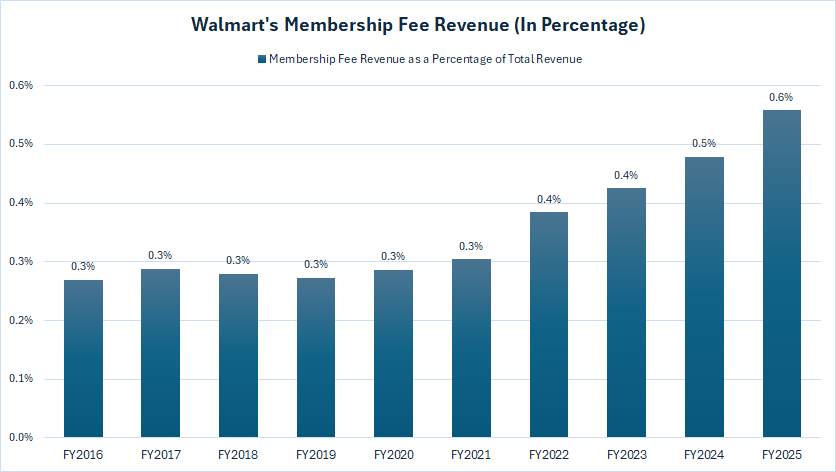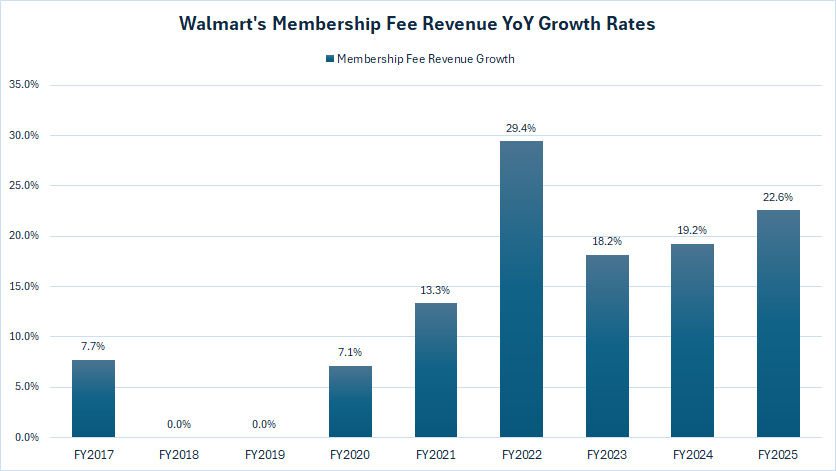
Black berries. Pexels Images.
This article presents Walmart’s membership fee revenue.
Walmart’s membership fee revenue falls under the Membership and Other Income category, which also includes other revenue streams such as rental and tenant income, recycling income, gift card breakage income, as well as other income from corporate campus facilities.
In this article, we look at only Walmart’s membership fee revenue, excluding other income.
Let’s look at the numbers!
For other key statistics of Walmart, you may find more resources on these pages:
Revenue
- Revenue by region: U.S. and International,
- Revenue type: net sales and membership & other income,
- Revenue segments: U.S., International, and Sam’s Club,
Other Revenue Streams
- eCommerce revenue by segment: U.S., International, and Sam’s Club,
- Fuel sales revenue and profit margin,
Profit Margin
- Profit margin by segment: U.S., International, and Sam’s Club,
- Walmart vs Costco: profit margin comparison,
Other Statistics
- Capital expenditures breakdown,
- Comparable sales by calendar period,
- Worldwide store count and locations breakdown by region,
- revenue per store,
Please use the table of contents to navigate this page.
Table Of Contents
Definitions And Overview
O2. What drives the significant growth in Walmart’s membership fee revenue?
Membership Revenue
A1. Revenue from Membership Fee
Percentage
B1. Membership Revenue as a Percentage of Total Revenue
Growth
C1. Membership Revenue YoY Growth Rates
Summary And Reference
S1. Insight
S2. References and Credits
S3. Disclosure
Definitions
To help readers understand the content better, the following terms and glossaries have been provided.
Walmart Membership Fee Revenue: Walmart’s membership fee revenue primarily comes from Sam’s Club, its warehouse club division.
This revenue is generated through membership fees paid by customers to access Sam’s Club stores and benefits. There are two types of memberships: Plus and Club.
This revenue stream is separate from Walmart’s core retail sales and is a significant contributor to its overall profitability.
Sam’s Club U.S.: Sam’s Club is a membership-only warehouse club owned by Walmart. It was founded in 1983 and named after Walmart’s founder, Sam Walton.
The club operates on a bulk-buying model, offering discounted prices on a wide range of products, including groceries, electronics, and household goods.
Sam’s Club competes with other warehouse retailers like Costco and BJ’s Wholesale Club, providing exclusive member benefits such as cash rewards, fuel discounts, and free shipping for higher-tier members.
As of fiscal year 2025, Sam’s Club has over 600 locations across the United States, along with additional stores in Mexico and China.
What drives the significant growth in Walmart’s membership fee revenue?
Walmart’s membership fee revenue has seen notable growth due to several key factors:
-
Increased Membership Adoption: More customers are opting for Sam’s Club memberships, particularly the Plus tier, which offers additional perks like free shipping and cashback rewards.
-
Price Adjustments: Walmart has strategically adjusted membership fees, ensuring they remain competitive while maximizing revenue.
-
Enhanced Member Benefits: The company has expanded exclusive discounts, early shopping hours, and personalized offers, making memberships more attractive.
-
eCommerce Integration: Walmart has leveraged its growing online presence, offering members benefits like free delivery and improved digital shopping experiences.
-
Store Expansion & Accessibility: More Sam’s Club locations and improved accessibility have contributed to a larger membership base.
These factors have collectively driven Walmart’s soaring membership fee revenue over the years.
Revenue from Membership Fee
Walmart-membership-fee-revenue
(click image to expand)
Walmart derives its membership revenue primarily from Sam’s Club. You may find more information about the segment here: Sam’s Club U.S.
For the definition of Walmart’s membership revenue, you may refer to this section: membership fee revenue.
Walmart’s membership revenue has reached a new milestone, surging to $3.8 billion in fiscal year 2025, marking a 20% increase from the previous year. This significant growth underscores the company’s expanding membership base and strategic efforts to enhance member benefits.
Over the past few years, Walmart’s membership revenue has exhibited strong upward momentum. In fiscal year 2024, total revenue from membership fees was $3.1 billion, up from $2.6 billion in fiscal year 2023.
A key trend is that Walmart has only experienced a significant increase in membership revenue in recent periods, with the upward trend beginning in fiscal year 2021.
As seen in the chart, since fiscal year 2021, Walmart’s membership revenue has more than doubled, climbing from $1.7 billion to $3.8 billion in fiscal 2025.
Prior to this breakout growth, membership revenue had remained relatively flat, indicating that Walmart’s current trajectory is the result of strategic pricing, expanded membership perks, and digital integration.
This rise aligns with Walmart’s broader ambitions to strengthen customer loyalty and improve recurring revenue streams.
Membership Revenue as a Percentage of Total Revenue
Walmart-membership-fee-revenue-in-percentage
(click image to expand)
Walmart derives its membership revenue primarily from Sam’s Club. You may find more information about the segment here: Sam’s Club U.S.
For the definition of Walmart’s membership revenue, you may refer to this section: membership fee revenue.
Walmart’s membership fee revenue plays a relatively minor role in its overall financial structure, consistently accounting for less than 1% of total revenue in most periods.
In fiscal year 2025, membership fees contributed only 0.6% of Walmart’s total revenue, underscoring its relatively small footprint within the company’s broader revenue mix.
However, while the percentage remains low, the growth trajectory of membership revenue has been remarkable. Over the past decade, its share of total revenue has doubled, rising from 0.3% in 2016 to 0.6% in 2025, reflecting Walmart’s increasing emphasis on subscription-based revenue models.
This shift signals a broader trend toward leveraging memberships for enhanced customer retention and predictable income streams.
Despite its limited contribution compared to Walmart’s core retail and grocery operations, the long-term trend suggests that membership revenue is playing an increasingly important strategic role in shaping Walmart’s business model.
Membership Revenue YoY Growth Rates
Walmart-membership-fee-revenue-yoy-growth-rates
(click image to expand)
Walmart derives its membership revenue primarily from Sam’s Club. You may find more information about the segment here: Sam’s Club U.S.
For the definition of Walmart’s membership revenue, you may refer to this section: membership fee revenue.
Walmart’s membership revenue has witnessed substantial growth in recent periods, particularly from fiscal year 2021 onward.
Before this surge, membership fee revenue had remained relatively stable, but a clear turning point emerged, marking a shift in the company’s approach to subscription-based income.
From fiscal year 2021 to 2025, Walmart’s membership revenue has consistently expanded at a double-digit growth rate, averaging 20.5% annually over the past five years.
This sustained acceleration highlights Walmart’s strategic emphasis on strengthening its Sam’s Club membership model, enhancing consumer incentives, and optimizing its pricing structure.
A particularly noteworthy spike occurred in fiscal year 2024, when membership revenue grew at an impressive 22.6% year-over-year (YoY).
Insight
Essentially, Walmart’s membership revenue has transformed from a relatively stagnant stream into a rapidly growing segment of its business.
While it still represents a small fraction of total revenue — just 0.6% in fiscal year 2025 — its growth trajectory has been remarkable.
Since fiscal year 2021, membership revenue has more than doubled, averaging 20.5% annual growth over the past five years.
This acceleration suggests that Walmart is successfully leveraging subscription-based income to enhance customer loyalty and create more predictable revenue streams.
While membership revenue remains far smaller than Walmart’s core retail operations, its consistent upward trend signals a growing emphasis on recurring revenue models, similar to competitors like Costco.
References and Credits
1. All financial figures presented were obtained and referenced from Walmart’s annual reports published on the company’s investor relations page: Walmart Investor Relations.
2. Pexels Images.
Disclosure
We may use artificial intelligence (AI) tools to assist us in writing some of the text in this article. However, the data is directly obtained from original sources and meticulously cross-checked by our editors multiple times to ensure its accuracy and reliability.
If you find the information in this article helpful, please consider sharing it on social media. Additionally, providing a link back to this article from any website can help us create more content like this in the future.
Thank you for your support and engagement! Your involvement helps us continue to provide high-quality, reliable content.



